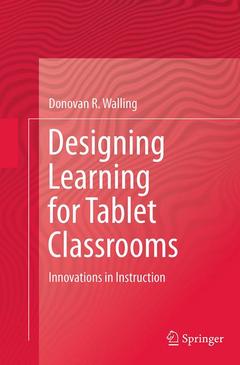Description
Designing Learning for Tablet Classrooms, 2014
Innovations in Instruction
Author: Walling Donovan R.
Language: English
Subject for Designing Learning for Tablet Classrooms:
Approximative price 84.39 €
In Print (Delivery period: 15 days).
Add to cartPublication date: 08-2016
Support: Print on demand
Approximative price 116.04 €
In Print (Delivery period: 15 days).
Add to cartPublication date: 02-2014
137 p. · 15.5x23.5 cm · Hardback
Description
/li>Contents
/li>Biography
/li>Comment
/li>
The versatile, cost-effective technology of the tablet computer has proved to be a good fit with the learning capabilities of today's students. Not surprisingly, in more and more classrooms, the tablet has replaced not only traditional print materials but the desktop computer and the laptop as well.
Designing Instruction for Tablet Classrooms makes sense of this transition, clearly showing not just how and why tablet-based learning works, but how it is likely to evolve.
Written for the non-technical reader, it balances elegant theoretical background with practical applications suitable to learning environments from kindergarten through college. A wealth of specialized topics ranges from course management and troubleshooting to creating and customizing etextbooks, from tablet use in early and remedial reading to the pros and cons of virtual field trips. And for maximum usefulness, early chapters are organized to spotlight core skills needed to negotiate the new design frontier, including:
- Framing the learning design approach.
- Analyzing the learning environment.
- Designing learning that capitalizes on tablet technology.
- Developing activities that match learning needs.
- Implementing the learning design.
- Conducting evaluations before, during, and after.
This is proactive reading befitting a future of exciting developments in educational technology. For researchers and practitioners in this and allied fields, Designing Instruction for Tablet Classrooms offers limitless opportunities to think outside the box.
Donovan R. Walling is a writer and editorial consultant. He also is a senior consultant for the Center for Civic Education and formerly was director of publications for Phi Delta Kappa International. Prior to moving into education publishing, he was a curriculum administrator in public school districts in Wisconsin and Indiana, following a lengthy career as a classroom teacher in Wisconsin and for the U.S. Department of Defense in Germany.
Walling is the author or editor of sixteen books. Recent titles include Why Civic Education Matters; Writing for Understanding: Strategies to Increase Content Learning; Teaching Writing to Visual, Auditory, and Kinesthetic Learners; Visual Knowing: Connecting Art and Ideas Across the Curriculum; Public Education, Democracy, and the Common Good; and Virtual Schooling: Issues in the Development of E-Learning Policy. He also has contributed articles to a number of professional journals, including a six-part series on student-produced media, titled “Tech-Savvy Teaching,” for the Association for Educational Communications and Technology (AECT) journal, TechTrends. He is the co-author (with Phillip Harris) of “Policies Governing Educational Technology Practice and Research” (Chapter 50) in Handbook of Research on Educational Communications and Technology, Fourth Edition. He also edits and designs the AECT quarterly e-newsletter, iTECH DIGEST.
Walling has written monographs; contributed articles to encyclopedias; provided pre- and post-publication book reviews; contributed chapters to various books, including scholarly history; published poems in journals and anthologies; and written several produced scripts for radio and stage as well as short story fiction. His Arts in View blog, which he began in 2009, is read literally around the world, as is his other blog, Advancing Learning and Democracy, which was launched in 2012. He was a founding associate editor of the Journal of Ga
Focuses on instructional design for tablet computers
Emphasizes practical applications of tablet technology in teaching and learning
Provides a solid resource for teacher educators and classroom practitioners as well as support and supervisory personnel
Distinguishes and highlights innovative tablet-mediated teaching and learning as distinct from traditional instruction
Includes supplementary material: sn.pub/extras

